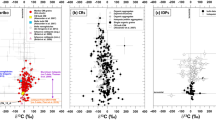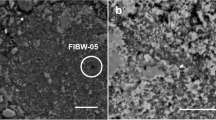Abstract
IN their recent article1, Claus and Suba-C reiterate a number of older arguments in favour of a biogenic origin of the non-birefringent, globular objects in the Orgueil meteorite. I am of the opinion that these are microchondri of glass and I have previously expounded my arguments in favour of this2.
This is a preview of subscription content, access via your institution
Access options
Subscribe to this journal
Receive 51 print issues and online access
$199.00 per year
only $3.90 per issue
Buy this article
- Purchase on Springer Link
- Instant access to full article PDF
Prices may be subject to local taxes which are calculated during checkout
Similar content being viewed by others
References
Claus, G., and Suba-C., E. A., Nature, 204, 118 (1964).
Mueller, G., Nature, 196, 929 (1962).
Mueller, G., in Advances in Organic Geochemistry. Proc. Intern. Meeting, Milan, 1962, 114 (Pergamon Press, London and New York, 1963).
Author information
Authors and Affiliations
Rights and permissions
About this article
Cite this article
MUELLER, G. Interpretation of Micro-structures in Carbonaceous Meteorites. Nature 205, 1200–1201 (1965). https://doi.org/10.1038/2051200c0
Published:
Issue Date:
DOI: https://doi.org/10.1038/2051200c0
This article is cited by
-
Extra terrestrial abiogenic organization of organic matter: The hollow spheres of the Orgueil meteorite
Space Life Sciences (1971)
-
Review of organic matter in the Orgueil meteorite
Space Life Sciences (1971)
Comments
By submitting a comment you agree to abide by our Terms and Community Guidelines. If you find something abusive or that does not comply with our terms or guidelines please flag it as inappropriate.



